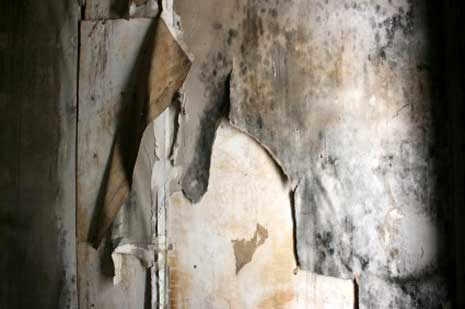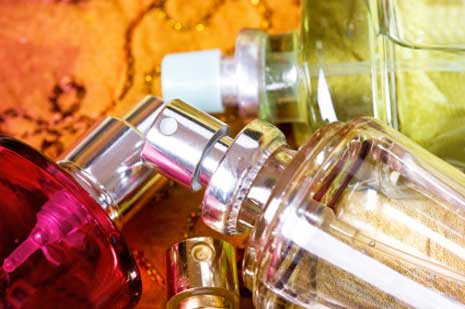Causes of mildew in the house
Construction and other influences which promote the growth of mold
Mold needs nutrients and moisture to grow. As always, building nutrients are present and readily available in various forms, but the moisture in a building will play a crucial role. The moisture threshold is about 70% and below relative humidity at the surface which no growth from mold to materials will occur. As the moisture content increases so will the likelihood of mold growth. At 80% relative humidity at the surface, the growing conditions for almost all indoor air mold species are reached. At even higher surface moisture all mold and bacteria can grow. However it must be noted that the growth conditions of humidity and temperature cannot be considered separately, since the position of the minimum and optimum moisture can move at different temperatures. The minimum values of relative humidity which are necessary for germination or mycelium growth can be achieved only at optimal temperatures. When these optimal temperatures are there, germination or mycelial growth takes place only at higher humidity.
Conditions for mold growth
In addition to the interaction of moisture and temperature, the pH range for growth of mold is also important. The optimum growth range is between pH 5 and pH 7, taking into account that some species of mold grow are in a pH range from 2 to 11. Wallpaper and paint, for example, often have a pH of 5 to 8. Calcareous materials, like plaster for example, or concrete can have pH values above 12. Nevertheless, even then there can be mold growth if, for example, thin biofilms were formed on the material. This medium is due to dust or trapped grease, deposits, etc. available in sufficient quantity on all component surfaces.
Mold is formed only under certain conditions
Basically, mold growth can occur only if the above growth conditions are met. Moisture plays a significant role. This is important to note that hot air – with the same relative humidity – contains more moisture than cold air. This moisture can come from the structure itself or introduced by the room users.
The factors that may be responsible for increased moisture in the building can be summarized as follows:
- Inadequate insulation and low heat storage
- Thermal bridges
- Increased heat transfer resistance
- Insufficient or inadequate heating
- Increased production of moisture in the interior
- Inadequate or improper ventilation
- Poor moisture buffering of building materials
- Moisture in the building construction
- Thermal bridging, insulation
In winter the building can be well dried at low temperatures by venting the air. The cold outside air is heated in the apartment and takes on additional moisture that is transported with the fan to the outside. On the other hand, it can be critical in warm humid places in the apartment to cool the air. For example, this is important in cooler areas like bedrooms or for thermal bridges like corners. In general, it can be assumed that is achieved at a room temperature averaging 21 ° C and a surface temperature of the inner surface of the outer wall of 11 ° C dew point. When below this 11 ° C, the state of the air runs along the saturation line, it creates condensation on the cooler surface. In this case it is necessary to perform thermal insulation of the walls to the interior wall surface to increase temperature.
It must be noted however, that the insulation may be confused with the heat storage. A higher heat storage capacity for heavy building materials (solid walls) can compensate for temperature fluctuations better than lightweight structures and thus also provide a better buffer of the air. Sufficient insulation, proper ventilation, and heating are crucial for the prevention of mold.
Furniture, curtains, and the like are hardly resistant to humidity, like the indoor humidity which penetrates behind the furniture to the walls. At the same time the heat gets into a space by a reduced convective, and then radiating heat is transferred behind furniture and curtains. The wall along such areas means the relative indoor humidity is increased and can lead to mold growth. Therefore, care should be taken to have sufficient convection behind such furnishings.
Temperature regulation, moisture reduction
An increase in air temperature is caused by heat – at the same absolute water content of the air – a decrease of relative air humidity. It also is increased by heating the room, the surface temperature of the inner walls. Both effects contribute to a reduction in the risk of mold growth. If single rooms are not heated or even less, rises in reverse, there is the risk of mold growth. This is particularly true in areas (like bedrooms) that may be used for many hours. A lot of moisture is produced, and it increases the humidity and cold walls are at the risk of condensation. Therefore, unused or little used rooms should be heated slightly over a longer period. Doors to seldom used rooms should be closed. It does not make sense to control the temperature of cool rooms with air from warmer areas. This means consumers will not only heat them, but also the moisture is carried into the cooler room. If the air then cools, the relative air humidity changes and turns on the risk of mold growth. Here, too, it is important to note that the surface moisture on the inner surfaces of outer components is not only related to the ambient humidity, but also is dependent on temperature differences between air and surface. This is significantly influenced by the moisture production in the living room. A high moisture production leads to higher air humidity and thus to higher surface moisture. The ventilation is the most effective means to remove moisture from the home. An exchange of air from the interior to the outside walls of the structure is often mistakenly believed there but it is not the case. The term used in this context, like the “breathing wall” is only seen in connection with the regulation of humidity (moisture buffering).
The moisture regulation will change according to the wall’s ability to take in or release water into the room’s air. As mentioned, solid walls usually have a stronger buffering effect than lightweight structures. The speed and possibility of compensation for the absorption depends strongly on the porosity and the ab-and desorption of the building materials used. A brick has a higher porosity than many natural stones and is therefore cheaper in the humidity regulation.
Proper ventilation
The ventilation of living spaces means the actual exchange of air. Convection (air movement) can only come through different air temperature states. If one allows the windows to remain open in the wintertime with the radiators turned off, then the air exchange isn’t as efficient. A temperature balance between outdoor and indoor air leads to the stoppage of ventilation. If the radiators are turned off near the titled windows, airflow is stagnant and there is not a good air exchange.
Therefore it doesn’t make any sense to open all windows before leaving the house in the morning. Make sure the heating is off before leaving the house. On behalf of the Federal Environmental Agency in relation to the proper ventilation of the living space, see the following information:
The most effective way to remove moisture from the living space is by doing cross ventilation several times a day. This short-term procedure (5-10 mins., depending on the number and arrangement of windows) will help to remove moisture. If this moisture can only be released in the morning after rising, according to season, room size and air temperature, etc. it is best to ventilate for 30-40 mins. (shock and / or cross ventilation). Only ventilating at night is not a good idea. Then the room must be aired for a longer time (1 hour and longer), because the moisture has been fixed in the walls and furniture, and only slowly escapes. During the ventilation, the heating shouldn’t be stopped completely. In this regard, noted that on a long term ventilation is not recommended because of the tilted windows which are associated with high heating costs. Also the removal of the corpus lip seals in newer, thick windows is not recommended in any case.
It is recommended if one cannot ventilate correctly, to then install a ventilation and air-conditioning (HVAC system) in the house. HVAC systems provide fully automatic proper ventilation and heating exchange due to their characteristics (the exhaust heat warms the fresh air) and it also contributes to energy conservation.
Conclusion:
Mold on interior walls have at least one adverse health effect, contrary to many opinions. The causes of mold growth can be discovered by examining the civil engineering of the building. It is therefore recommended always to seek professional advice directly at the scene. Experts in evaluation would include a biological and building surveyor.
Author:
Gerhard Holzmann; Holzmann-Bauberatung; Certified expert office, construction and management consultant – so that everything fits like it should – www.Baubegriffe.com Phone 0049-8293-965648
Translation: Christi Howarth for CSN – Chemical Sensitivity Network
Original article: Ursachen von Schimmelbildung im Haus
Related Articles:
- Patients with indoor exposure to molds compared to patients exposed to chemicals
- A longitudinal study of environmental risk factors for symtoms associated with sick building syndrome
- Autism – Do terbutaline and mold associated impairments of the brain and lung relate to Autism?
- Successful treatment of patients with mycotoxin induced disease






